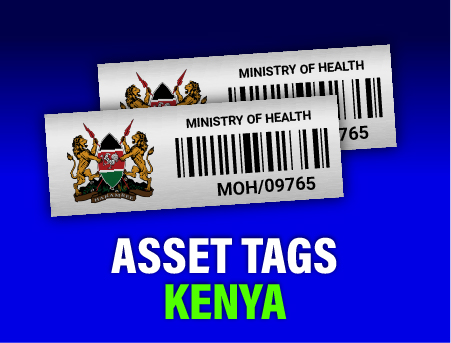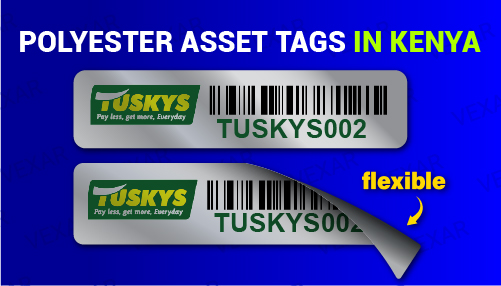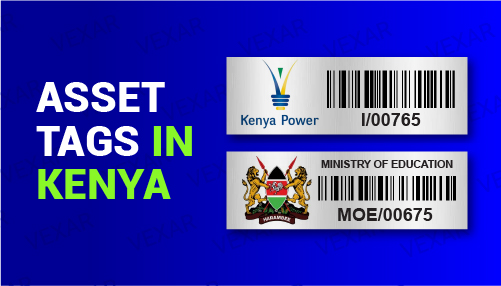QR Code Asset Tags Kenya – Modern Tracking for Smarter Businesses
QR Code Asset Tags Kenya are revolutionizing how businesses manage their fixed assets, equipment, and inventory. By combining durable aluminium or polyester labels with quick-response (QR) codes, organizations can instantly access asset details using a smartphone or scanner. This modern tagging solution enhances accuracy, accountability, and speed — making it the preferred choice for smart asset management in Kenya and across Africa.
Why QR Code Asset Tags Are Changing Asset Management
In today’s data-driven world, manual asset tracking is no longer efficient. QR code asset tags transform traditional labels into smart identifiers that store dynamic information — from serial numbers and purchase dates to maintenance history and location data. A simple scan links directly to your digital asset record, improving transparency and decision-making.
Organizations using asset management software in Kenya have seen measurable improvements in audit speed and data accuracy. Instead of manually cross-checking spreadsheets, employees simply scan each asset’s QR code to confirm details instantly. This technology also integrates seamlessly with fixed asset tagging services offered by professionals like Vexar Solutions.
How QR Code Asset Tags Work
Each QR code asset tag contains a unique code printed on a durable material such as aluminium, polyester, or vinyl. When scanned, the code directs users to a digital record — typically hosted on a secure database or asset management system. This record contains asset-specific data, maintenance logs, warranty details, and even user manuals.
Unlike barcode labels, which store limited data, QR codes can hold hundreds of characters, including URLs. This flexibility allows organizations to create interactive asset tracking systems. For instance, a hospital in Nairobi can scan a tagged medical device to access service history or warranty information instantly — improving operational efficiency and compliance.
Benefits of Using QR Code Asset Tags in Kenya
- Instant Information Access: Staff can retrieve asset details using any smartphone — no expensive scanners required.
- Accurate Inventory Management: Reduces human error in audits by digitally verifying each item.
- Cost Efficiency: Affordable setup with high return on investment compared to manual systems.
- Improved Accountability: Tracks user and departmental responsibility for each tagged item.
- Smart Maintenance Scheduling: Links to online maintenance logs or reminders for scheduled servicing.
When paired with aluminium asset tags or polyester asset tags, QR codes withstand harsh conditions while keeping data accessible. The result is a durable, digital-first tracking method designed for the modern Kenyan enterprise.
Material Options for QR Code Asset Tags
Depending on where your assets are located, you can choose from different materials for QR code tags:
- Aluminium QR Tags: Ideal for outdoor or industrial environments. Resistant to heat, solvents, and abrasion.
- Polyester QR Labels: Flexible and cost-effective, perfect for office equipment and electronics.
- Acetone Activated QR Tags: For permanent bonding on metal or painted surfaces — see our acetone activated asset tags.
Each material can be printed with barcodes, sequential numbering, or customized graphics. Companies looking to maintain consistent branding across assets can explore custom asset tag printing for cohesive and professional finishes.
How QR Code Tags Support Compliance and Auditing
QR Code Asset Tags Kenya provide a digital trail for every item — essential for audit readiness and regulatory compliance. Government departments, NGOs, and schools increasingly rely on them to maintain traceable asset histories. During audits, scanning the tag immediately reveals acquisition details, location, and custodian records, streamlining the process.
In Nairobi, a leading logistics company recently adopted QR-based tracking to monitor field equipment and returnable assets. The result? A 60% reduction in audit time and fewer discrepancies in asset reports. This case demonstrates how simple technology can yield big efficiency gains across the Kenyan business landscape.
Integrating QR Tags with Asset Management Software
QR tags work best when integrated with powerful digital tools like Snipe-IT or other asset management systems. Once linked, each scan updates asset records automatically — reducing manual entry and human error. For companies managing thousands of assets across multiple sites, this automation is invaluable.
To understand global standards for tagging and identification, explore resources from the GS1 Global Standards Organization. Their guidelines influence how modern tracking codes maintain interoperability worldwide, including across African supply chains.
Design and Printing Considerations
Effective QR code design balances aesthetics, functionality, and scan reliability. Key considerations include:
- Using high-contrast black and white printing for maximum readability
- Protecting the QR surface with lamination or anodized sealing
- Ensuring tag size fits the asset but remains easy to scan
- Embedding redundant data in the code for backup verification
For long-term visibility, we recommend anodized finishes that protect the QR print from scratches, oil, or cleaning solvents. Learn more about anodized aluminium tags to see how surface treatments extend tag life even in rough industrial conditions.
Security and Anti-Tamper Features
To prevent fraud or unauthorized asset transfers, QR code labels can include tamper-evident or destructible backing. Once applied, any attempt to remove or reposition the tag results in visible damage, discouraging manipulation. For higher security, tamper-proof aluminium asset tags integrate holographic seals and serialized tracking to ensure authenticity.
Industries such as banking, telecommunications, and education benefit greatly from these security layers. They not only secure physical assets but also maintain accurate audit trails within asset management systems.
QR Code Tags for African Businesses
Across Africa, QR code asset tagging is growing fast — particularly in logistics, education, and public infrastructure. As countries digitize asset records, QR codes offer an accessible and low-cost entry into smart asset tracking. Kenyan businesses are leading this transformation, using modern tags to manage inventory across warehouses, offices, and transport fleets.
For a broader look at how digital transformation is shaping asset tracking, visit African Business Central, which covers regional trends in business innovation and digital adoption.
Partner with Experts in QR Asset Tagging
At Vexar Solutions, we specialize in designing, printing, and deploying QR Code Asset Tags Kenya tailored to your operational needs. Whether you require permanent aluminium tags, chemical-bonded labels, or serialized QR codes linked to your database, we provide end-to-end solutions to streamline tracking and accountability.
Our team can assist with asset tagging services, data integration, and even software deployment for complete automation. From design to field tagging, we ensure accuracy, durability, and efficiency at every stage.
Conclusion
QR Code Asset Tags Kenya represent the future of asset management — bridging the gap between physical assets and digital data. They simplify audits, prevent loss, and enhance operational transparency. For organizations seeking smarter, scalable solutions, QR tagging isn’t just an upgrade — it’s a necessity for modern business efficiency.
Contact Vexar Solutions today to implement QR Code Asset Tagging and modernize your asset management system with intelligent, future-ready technology.






